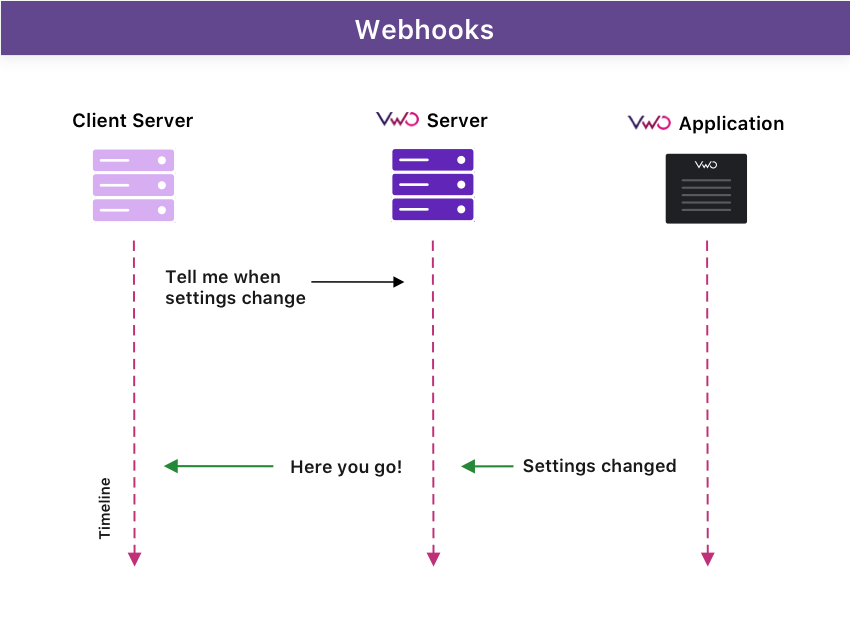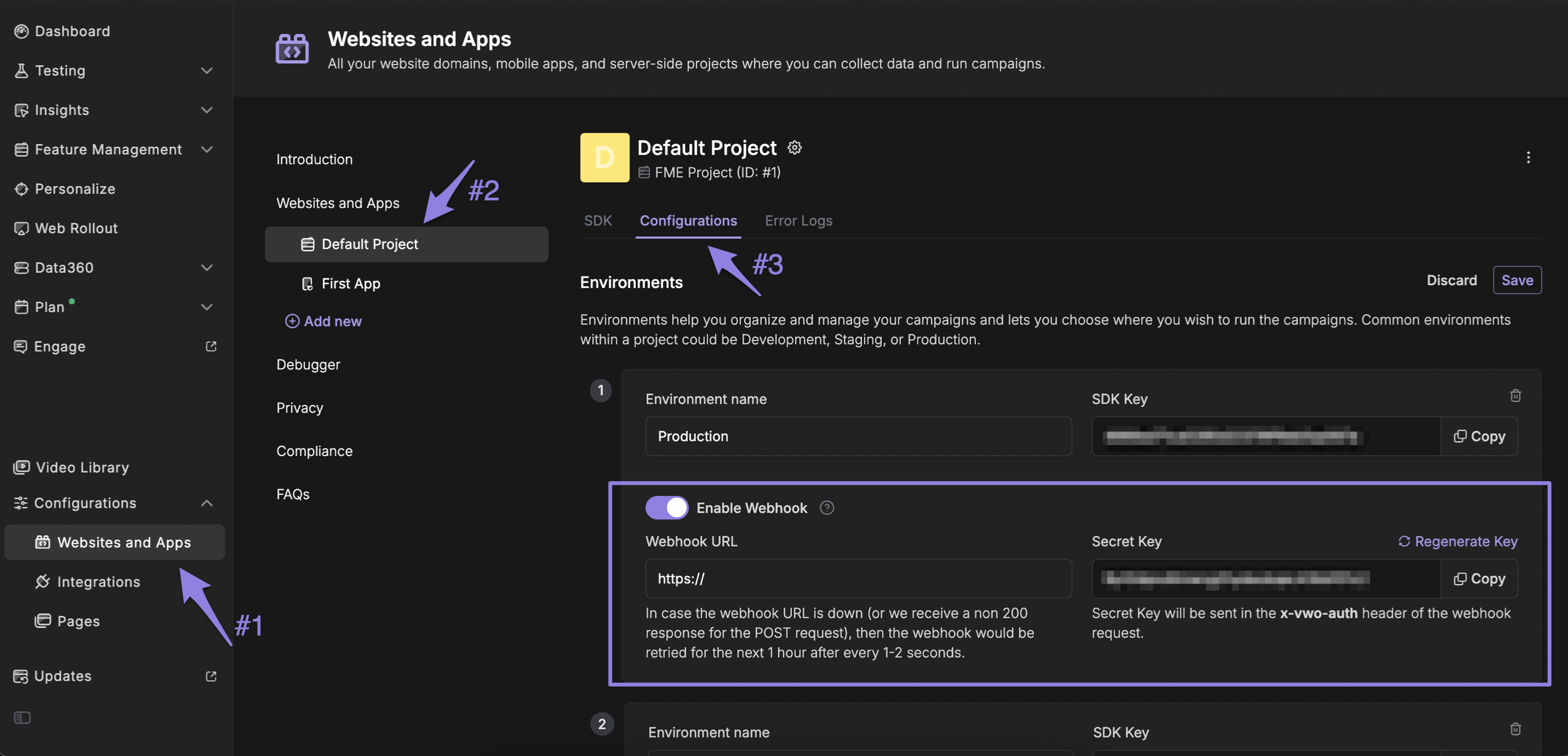Configuring Webhooks
Overview
Webhooks are user-defined HTTP callbacks or push APIs. They are a way for one system to provide real-time data or event notifications to another system by sending an HTTP POST request to a URL configured by the recipient system. Unlike APIs, which are pulled (the client must send a request to receive data), webhooks are pushed (the server sends data when an event occurs).
This makes webhooks ideal for event-driven integrations, allowing you to respond instantly to events in an external service, such as feature flag changes, campaign activations, or user configuration updates.
Key Characteristics:
- Event-driven: Webhooks are invoked only when a particular event occurs.
- Lightweight communication: Usually performed over HTTP POST with a JSON payload.
- One-way communication: They notify, not expect a response.
- Near real-time: As soon as the event is triggered, data is pushed.
Key Features:
- Push-based system: Immediate delivery on configuration changes
- Reduces SDK polling overhead
- Secure delivery with HMAC-SHA256 signature
How Webhooks Work
- Event Occurs: An event happens in the source system (e.g., a feature flag is modified in a control panel).
- Webhook Triggered: The system detects this event and immediately sends an HTTP POST request to a pre-configured URL (the webhook listener endpoint).
- Payload Delivered: This POST request contains a JSON (or optionally other formats) payload with data relevant to the event.
- Consumer Acts: The receiving server processes this data and performs any required logic, like updating cache, triggering workflows, or logging events.

How Webhooks Work
Role of Webhooks in VWO FE SDKs
VWO FE SDKs fetch configuration settings (features, campaigns, variations) from the VWO servers. By default, they periodically poll for updates. Webhooks allow a more efficient and scalable solution by enabling:
- Real-time config sync: No delay between a change on the dashboard and its reflection in the SDK.
- Hot-reloading support: SDK settings are updated in-memory using the webhook payload.
- Stateless server design: Webhooks help ensure distributed services are always up-to-date without storing stale configs.
Enabling Webhooks in VWO
- Log in to your VWO account.
- Navigate to
Configurations→Website and Appsfrom the left-hand panel. - Select the
Default Projectassociated with your FE setup. - Click on the
Configurationstab. - Under the Environment(s) section, enable the Webhook option for the specific environment(s) you want to subscribe to for configuration change events.
- In the
Wehook URLfield, provide the endpoint URL where you want to receive webhook notifications. - Click SAVE to apply your changes.

Configuring FE Webhooks in VWO
Once saved, VWO will start sending HTTP POST requests to your configured URL whenever relevant configuration changes occur in the selected environment(s).
Securing Webhooks with API Key-Based Authentication
When setting up a webhook in the VWO app, it’s essential to ensure that your endpoint only accepts requests from trusted sources, i.e., from VWO itself. To facilitate this, VWO supports API key-based authentication using a secret key.
How It Works
- During webhook configuration in the VWO dashboard, you can generate a secret key specifically for that webhook.
- Every time VWO triggers the webhook (via an HTTP
POST), it will include this secret key in the request header:x-vwo-auth: YOUR\_SECRET\_KEY - On your server, your webhook handler should:
- Read the value of the
x-vwo-authheader from the request. - Compare it with the secret key you generated and securely stored during setup.
- Reject the request (e.g., with a
401 Unauthorized) if the key does not match.
- Read the value of the
This approach ensures that only authenticated POST requests from VWO are accepted by your application, effectively preventing any third-party or malicious source from spoofing webhook events.
Regenerating the Secret Key
If the key gets exposed or you suspect unauthorized access, you can regenerate a new secret key from within the VWO app. Once updated:
- VWO will use the new key for all future webhook calls.
- You must also update your server-side logic to validate against the new key.
Note🔒 Keep your secret key secure, do not expose it in frontend code, logs, or error messages.
Webhook Payload Format
Whenever a settings change occurs (e.g., feature flag modified, campaign updated), VWO triggers a webhook request to your configured endpoint. This is an HTTP POST request with a JSON payload that contains metadata about the event.
Payload Fields Explained:
{
"timestamp": 1606482285,
"event": "settings_changed",
"action": "campaign_settings_changed",
"triggered_by": "vwo"
}| Field | Description |
|---|---|
timestamp | UNIX timestamp (in seconds) indicating exactly when the change occurred. Useful for logging and event ordering. |
event | Describes the type of event. Currently, this is always "settings_changed" for VWO SDK-related updates. |
action | A more specific indicator of what changed, for example, campaign_settings_changed, feature_flag_updated, etc. |
| `triggered_by | Source of the event trigger, usually "vwo"; this may help in filtering internal vs external triggers in future support. |
While this payload doesn't contain the full settings, it acts as a notification that the settings have changed — and is particularly useful for lightweight validation or logging before calling the SDK update method.
Usage
// Assuming Express server
const express = require('express');
const app = express();
// require VWO SDK
const { init } = require('vwo-fme-node-sdk');
let vwoClient = await init({
accountId: 'VWO_ACCOUNT_ID',
sdkKey: 'VWO_SDK_KEY'
});
const webhookAuthKey = 'SECRET_WEBHOOK_KEY_GENERATED_IN_VWO_APP';
// Endpoint to subscribe to changes made in VWO FullStack running campaigns
app.post('/vwo-webhook', async (req, res) => {
console.log('WEBHOOK TRIGGERED', req.body, 'Webhook Auth Key:', req.headers['x-vwo-auth']);
if (webhookAuthKey && req.headers['x-vwo-auth']) {
if (req.headers['x-vwo-auth'] !== webhookAuthKey) {
console.error('VWO webhook authentication failed. Please check.');
return;
} else {
console.log('VWO webhook authenticated successfully.');
}
} else {
console.log('Skipping Webhook Authentication as webhookAuthKey is not provided');
}
// You may want to fetch the updated settings so that SDK can use the same
await vwoClient.updateSettings();
res.end(JSON.stringify({
status: 'success',
message: 'Webhook received and Settings updated successfully'
});
});
app.listen(4000, () => {});# Assuming Flask server
# require VWO SDK
import vwo
from flask import Flask, request, abort, make_response
@app.route('/vwo-webhook', methods=['POST'])
def webhook():
print('WEBHOOK TRIGGERED, {body}, Webhook Auth Key: {webhook_auth_key}'
.format(
body=request.json,
webhook_auth_key=request.headers.get('x-vwo-auth')
)
)
WEBHOOK_AUTH_KEY = AccountDetails.get('webhook_auth_key')
if WEBHOOK_AUTH_KEY and request.headers.get('x-vwo-auth'):
if WEBHOOK_AUTH_KEY != request.headers.get('x-vwo-auth'):
print('VWO Webhook authentication failed')
abort(401)
else:
print('VWO Webhook authentication successful')
else:
print('Skipping authentication as missing webhook authentication key')
if vwo_client:
vwo_client.update_settings()
return make_response({'status': 'success', 'message': 'settings updated successfully'}, 200)// Endpoint to subscribe to changes made in VWO FullStack running
@PostMapping("/vwo-webhook")
@ResponseStatus(HttpStatus.OK)
public void webhook(
@RequestHeader("x-vwo-auth") String secretKey,
@RequestBody String body
) {
String webhookAuthKey = "SECRET_WEBHOOK_KEY_GENERATED_IN_VWO_APP";
if (webhookAuthKey != null && secretKey != null) {
if (secretKey.equals(webhookAuthKey)) {
System.out.println("VWO webhook authenticated successfully.");
} else {
System.out.println("VWO webhook authentication failed. Please check.");
return;
}
} else {
System.out.println("Skipping Webhook Authentication as webhookAuthKey is not provided.");
}
if (vwoClient != null) {
vwoClient.updateSettings();
System.out.println(vwoClientInstance.getSettingFileString());
}
}[Route("/webhook")]
[HttpPost]
public async Task<string> webhook()
{
CustomLogger logger = new CustomLogger();
logger.WriteLog(LogLevel.DEBUG, "Post request from vwo app");
string PayLoad;
using (StreamReader reader = new StreamReader(Request.Body, Encoding.UTF8))
{
PayLoad = await reader.ReadToEndAsync();
}
logger.WriteLog(LogLevel.DEBUG, "VWO webhook payload: " + PayLoad);
bool isAuthenticated = true;
if (!string.IsNullOrEmpty(Defaults.WebhookSecretKey))
{
logger.WriteLog(LogLevel.DEBUG, "WebhookSecretKey exists . VWO webhook authentication Checking.");
if (Request.Headers["x-vwo-auth"].ToString() != Defaults.WebhookSecretKey)
{
logger.WriteLog(LogLevel.DEBUG, "VWO webhook authentication failed. Please check.");
return "VWO webhook authentication failed. Please check.";
}
}
if (VWOClient != null)
{
logger.WriteLog(LogLevel.DEBUG,
string.IsNullOrEmpty(Defaults.WebhookSecretKey)
? "UpdateSettings function called"
: "Authentication passed and UpdateSettings function is called");
await VWOClient.UpdateSettings();
logger.WriteLog(LogLevel.DEBUG, "Setting has been updated");
}
return "";
}
# Assuming Sinatra server
require 'vwo'
post '/webhook' do
content_type :json
if config['webhook_auth_key'] and request.env['HTTP_X_VWO_AUTH']
if config['webhook_auth_key'] != request.env['HTTP_X_VWO_AUTH']
puts('webhook api authentication failed')
return {'status': 'failed', 'message': 'webhook api authentication failed'}.to_json
else
puts('Webhook api authentication successful')
end
else
puts('Skipping authentication as missing webhook authentication key')
end
vwo_client.update_settings
return {'status': 'success', 'message': 'settings updated successfully'}.to_json
endWebhook Retries
If the webhook endpoint is unavailable or returns a non-2xx HTTP response, VWO will automatically retry the request for up to 1 hour, with retry attempts made every 1 to 2 seconds. This ensures resilience in the event of temporary network issues or server downtime.
Testing Webhooks
To test your webhook integration, you can use tools like RequestBin or Webhook.site. These tools allow you to inspect incoming POST requests, review payloads, and validate headers before integrating with your production endpoint.
Updated 4 months ago
